|
sito + "/AREA=" + sezione + "/AAMSZ=" + misura + "/ACC_RANDOM=" + bumber + "/PAGEID=" + pageid + "'>"); document.write(""); |
| home > allestimenti |
|
sito + "/AREA=" + sezione + "/AAMSZ=" + misura + "/ACC_RANDOM=" + bumber + "/PAGEID=" + pageid + "'>"); document.write(""); |
| home > allestimenti |
| Big
& Green James Hicks |
||||
| The
National Building Museum in Washington DC hosted, between January 17th
and June 22nd 2003, a significant exhibit on large-scale architectural
projects addressing environmentally sustainable methods and practices.
All issues that, given the explosive expansion of world cities in the
past centuries, often at odds with environmental concerns, are today
especially challenging. "Big & Green: Toward Sustainable Architecture
in the 21st Century" is introduced, on the pages of ARCH'IT, through
two presentations by David Gissen, curator of the exhibit, who describes
(Untangling the nature of sustainable
architecture) how, with a genuine sense of curiosity as well as
a sense of irony, he untangle the "nature" of sustainable
architecture while attempting to explain how environmentalism and big-business
interacted; and James Hicks, the architect in charge of the exhibit
design, who designed an exhibition about sustainable building principles
while upholding said principles. [PG] |
||||
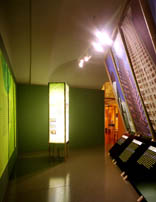 The introduction kiosk. |
Good
exhibition design facilitates communication and the creation of meaning.
It does this by acting on a conscious as well as a subconscious, visceral
level. Good design can make the difference between an exhibition that
one soon forgets and an exhibition that stays in one's mind for years. The exhibition "Big & Green: Toward Sustainable Architecture in the 21st Century" occupied 7,000 square feet at the National Building Museum in Washington D.C. Distributed over 6 rooms, the exhibition translated the book by the same name into a 3 dimensional experience. Edited by the curator, David Gissen, Big & Green surveys 50 large-scale architectural projects (at least 35 were accompanied in the exhibition by scale architectural models) all of which address environmentally sustainable methods and practices. The survey is contextualized by five "critical essays" by leading thinkers on current attempts by the architecture and building professions to develop sustainable practices. The structure of Gissen's book is clear. The 50 projects, each occupying 2 pages, are arranged according to one of five sections: Energy Generation; Light and Air; Greenery, Water and Waste; Construction; and Urbanism. While many projects fall into more than one section, their most notable features are used to categorize them. Each section was accompanied by a "critical essay". As spatial divisions of the exhibition mirrored the organization of the book, the design team kept the content of the "critical essays" separate from the rest of the exhibition by distilling the contents and displaying it, along with didactic graphics and videos, on internally-illuminated, stand-alone kiosks. The kiosks functioned much like the essays do in the book, and offered context to the project in the form of stats and advocacy. Initial challenge: The vast majority of exhibitions in the U.S. consume vast amounts of energy and resources to construct and maintain; they create tons of refuse; and they add absolutely nothing to the biomass of the planet. |
[28aug2005] |
||
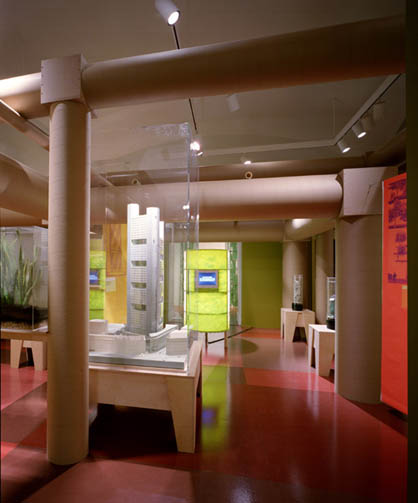 The Greenery, Water and Waste room . The exhibition design team solved the initial challenge 'how to design an exhibition about sustainable building principles while upholding said principles' by specifying recycled and recyclable cardboard tubes as the primary material for the exhibition; no adhesives, glue or paint was to be used on any of the potentially recyclable material, because to do so would prevent recycling. The cardboard tubes were manufactured within 50 miles of Washington D.C.; thus the tubes had a low embodied energy (if the tubes had been trucked from California, the energy of the fuel to power the truck for the 4,000 km drive would have negated the energy and resource savings we achieved by using them). The other primary material we specified for the exhibition was bamboo plywood. Bamboo is fast-growing (as much as a foot per day) and can be used to make very strong plywood. The museum bought what it needed from a manufacturer from within the continental US (again, if we had had to buy this bamboo plywood from Thailand, all the resource savings to be gained by using it would have been spent in shipping). |
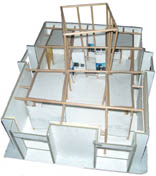 Study model of the Energy Generation room.  Study model of the introduction room. |
|||
 Study sketch . The design team developed three schemes which we presented to the curator and museum staff. Each scheme had its own distinct method of spatial organization as well as its own method of creating joints and structures out of the tubes. We came out of the first presentation with an approval on the material palette and a directive to amalgamate two of our schemes into one so as to better communicate the ideas of the curator and the museum. The revised scheme gained approval a few weeks later. While we began development of the approved scheme, the exhibition preparatory staff at the NBM ordered a dozen cardboard tubes, with which they began to experiment. This is just one example of how the museum partnered with the design team on this exhibition to the effect of greatly increasing the quality of the end product. |
||||
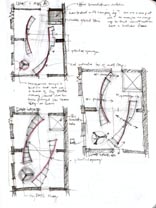 Study sketch. |
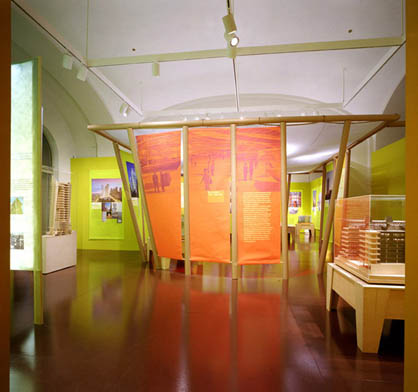 The Light and Air pavilion. The challenge faced in the design development phase was how to create what I referred to in the beginning of this essay as "meaning thru form and material" in the design environment that would complement the textual and graphic narrative of the exhibition. The overall plan allotted a separate space to each of Gissen's five themed sections. Our design gave each section its own individual spatial identity: its own "gestalt" which enhanced the reading of the contents. The most successful environment at effecting this "gestalt" was the one created for the section "Greenery, Water & Waste". |
|||
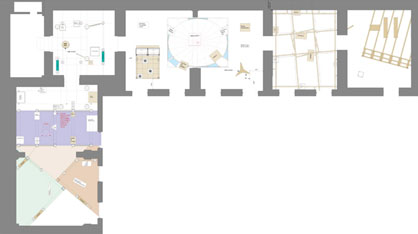 Exhibit layout . "Greenery, Water and Waste" summons up images of thousands of cubic feet in mega-structures given over to pipes that collect, divert and dump into the surrounding environment tons of sewage and other wastes that the systems in the structures create. The environment in the section "Greenery, Water and Waste" simulated a looming, dense and dimly-lit room full of enormous pipes and risers in a typical mega-structures. Situated in this tangle of cardboard tubes were the architectural models and graphic panels of the exhibition and several sealed terrariums containing live plants. |
||||
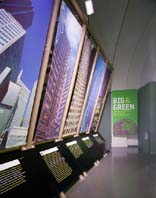 The introduction room. |
 The Urbanism room. The terrariums solved another paradoxical dilemma the design team acknowledged at the beginning of the project; that we were designing an exhibition for the inside of a completely un-natural inorganic space of a museum about the architecture profession's attempts to redress humanity's destruction of the natural environment. We began to confront that paradox by introducing the organic elements of dirt and plants (even if only within sealed vitrines) into the sterile museum environment. James Hicks |
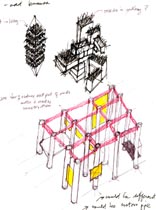 Study sketch . |
||
| Big
& Green: Toward Sustainable Architecture in the 21st Century |
||||
| >
ALLESTIMENTI: GISSEN: UNTANGLING THE NATURE OF SUSTAINABLE... > NATIONAL BUILDING MUSEUM |
||||
| ARCH'IT
books consiglia: David Gissen (Editor) Big & Green: Toward Sustainable Architecture in the 21st Century Princeton Architectural Press, 2002 pp192, acquista il libro online! |
||||||
| La
sezione Allestimenti laboratorio
|